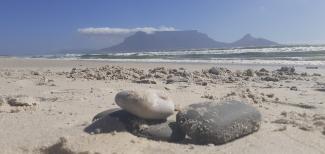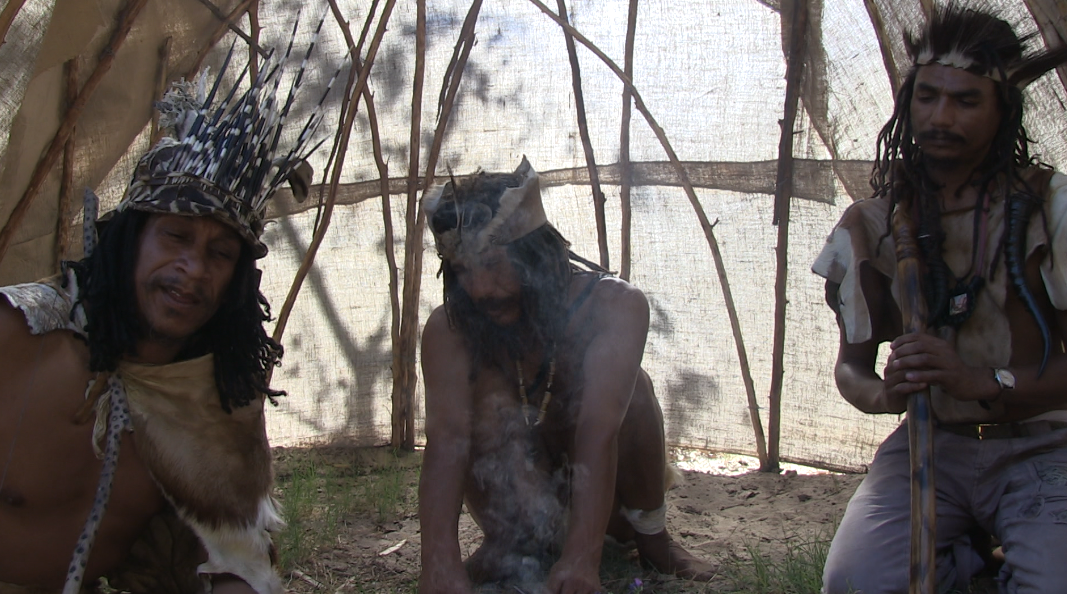
The sound of drums echoed in the streets of Cape Town, South Africa, on January 28, 2021, when the “Mountain 12” appeared at the Wynberg Magistrate Court. Supporters lined the streets displaying placards that called for the protection, honor, and respect of Aboriginal Peoples’ rights in South Africa. The Mountain 12 are a group of people from different Khoi and San Tribes who were arrested for trespassing by the South African police on January 1, 2021 while they were engaged in ceremonies at Table Mountain, a sacred site. Chelsea Smit Lee, Niel Moffat, Sharon Moffat, Wanda Danster, Clive Danster, Shane Chamberlain, Eric Bowers, Connie Smit, Bronwyn Paulsen, Edgar Smit, Gairoodeen Mitchell, and Timothy Maasdorp were all released on bail on January 2, 2021.
Hundreds, perhaps thousands of years ago, the people who inhabited Table Mountain and the surrounding area referred to as Huri ǂoaxa, the place where the clouds are gathered. The traditional name for Cape Town is ǁHuiǃGaeb. Today, Table Mountain is also a popular tourist attraction where many visitors use a cableway or hike to the top to overlook the city of Cape Town. The mountain forms part of the Table Mountain National Park. It is still a place of spiritual significance for local Indigenous Peoples.
According to the International Working Group for Indigenous Affairs’ Indigenous World 2020, in South Africa, it is estimated that approximately one percent of the 50 million total population are Indigenous Peoples. The Khoikhoi and San communities are not formally recognized as Indigenous in South Africa, nor are their languages recognized as official languages. During the Apartheid regime, Indigenous identification and cultures were discouraged, if not actually banned, and many Khoisan people were forced to learn Afrikaans as their primary language. Indigenous Peoples were similarly subjected to the impacts of colonialism and colonization for hundreds of years before that.
Kooigoed, an herb with spiritual significance, being burned at Table Mountain.
In October 2020, representatives from different Khoi and San Tribes formed an alliance with the intention of reclaiming Table Mountain, and occupied the site until their arrest on January 1, 2021. On January 28, the Mountain 12 appeared in court briefly. Proceedings adjourned when the accused and the State asked for more time to prepare. The Mountain 12 have asked for a Khoekhoegowab language interpreter to be present and the group are scheduled to reappear on February 24.
The Table Mountain alliance is citing international protections for their actions in Article 11 of the United Nations Declaration on the Rights of Indigenous Peoples, which states that: “Indigenous Peoples have the right to practice and revitalize their cultural traditions and customs. This includes the right to maintain, protect and develop the past, present and future manifestations of their cultures, such as archaeological and historical sites, artefacts, designs, ceremonies, technologies and visual and performing arts and literature.”
The fight for the Khoi and San Peoples to access and conduct ceremonies at their sacred mountain is fueled by their long lasting relationship with this sacred place. Tens of thousands of years before South Africa was colonized, the San and Khoi people called Table Mountain “Hoerikwagga” (Mountain in the Sea). The mountain was sacred for the Khoi and San, who believed their supreme god, Tsui//Goab,roamed there. The Khoi called Cape Town “Camissa,” the place of sweet waters, based on a stream that flows from under the mountain and into the ocean. Much has been written about the early meetings of seafarers and the “Strandlopers,” or beachcombers, who were at home in ǁHuiǃGaeb. Many accounts exist of famous Indigenous leaders such as Autsumao (Harry the Beachcomber),the chief of the Goringhaikanos, and Krotoa, who was married to a Dutch settler. Most of these accounts were written by the explorers who passed by, or who settled in South Africa. The name of Hoerikwagga was changed to Table Mountain in 1503, after Portuguese explorer Vasco Da Gama called it “Taboa da caba.”

Bradley Van Sitters, Timothy Maasdorp, and Rushwain Davids, members of the Khoi and San Alliance, reclaiming Table Mountain.
It was in 1652, however, after Jan Van Riebeeck anchored his ship in Cape Town, that permanent change would take hold. In the mid-1600s, the history of South Africa was at a turning point. Table Mountain, the landscape around it, and its inhabitants would forever be altered. Not only was this the beginning of colonialism in South Africa, but it is at this time when the country’s inclusion in the Transatlantic slave trade shaped the future of our Peoples. With the importing of enslaved people from West Africa, Madagascar, Southeast Asia, and elsewhere, miscegenation was inevitable, and very soon there was inter-marriage between people of European, African, Asian, and Indigenous South African Peoples. A racist attitude from colonizers has permeated South African history since the beginning of their invasion.
As early as 1655, and likely much earlier, there was known to be a form of worship in the Cape by Indigenous Peoples who lived there. The Supreme Being of the Khoi-Khoi, published in 1881, documents many acts of ceremony and describes how the Aboriginal Peoples of the region referenced both good and evil. It is on this basis that the alliance at Table Mountain, who are descendants of these ancestors, are now basing their reclamation of the Mountain as an historic place of spiritual significance.
Tazlyn Maasdorp, whose husband, Timothy Maasdorp,was among the arrested, stated on January 28: “It is a bittersweet moment yet again, this postponement [of the trial].However, the Mountain 12 greatly appreciate all the support and prayers from everyone. As this court case will go into our history books of tomorrow, the next generation will be proud of the sacrifices we are making today.”
In 2007, 144 States adopted the UN Declaration on the Rights of Indigenous Peoples. Thus far, however, not many have implemented it. In South Africa, Indigenous Peoples today still face much discrimination. Under the Apartheid regime, all Indigenous Peoples were classified together with the people of slave heritage and mixed heritage under the term “Coloured.” This group was, and still is, seen as distinct from other groups. There are still Indigenous people in South Africa who have strong connections to their roots, exercising the practices and traditions of their ancestors. There also exists a group who have been robbed of their languages and identities through assimilation into Western culture, speaking only Afrikaans or English.
With the advent of democracy in South Africa a revivalist culture is growing, and many people who were previously discouraged from identifying as Indigenous are now reconnecting with their roots. It is difficult to put an accurate number on how many Indigenous people are in the country, and there is much debate on the matter even among ourselves.
A 2011 census estimates that there are approximately 200,000 Nama speakers in South Africa, Namibia, and Botswana. A significant number of Khwedam and !Xun speakers reside in Platfontein, South Africa; the 2011 census figure puts this estimate at 8,000 in Southern Africa. A growing population of !Xun and Khwe people reside in Platfontein in Northern Cape, South Africa, where the state has founded XK FM in an effort to preserve and promote both !Xun and Khwedam
languages.
Out of 6,000,000 people who have been classified as “Coloured,” one has to search for clues such as facial features, surnames, place of birth, or spiritual links to identify who is Indigenous, and this makes it difficult to measure just how many people are of Khoi or San ancestry. DNA testing has made it possible for some to find out their origins, and initiatives are underway to assist communities in finding out more about their heritage.
Some eight years ago, the University of The Western Cape went out to communities and took DNA samples from so-called “Coloured” communities, and this is how it was confirmed to me that my lineage is that of some of the oldest people of the world, belonging to the Haplogroup L0d. People from this Haplogroup are estimated to have originated from 39,000 to 57,800 years ago. For 35 years of my life, I was convinced and happy to be something that I was not. This is the devastating power of colonialism; this is how what was done 400 years ago and still affects us today.
Indigenous leaders are now exercising their right to self-identification by identifying themselves as San and Khoi-Khoi or Khoe-San. Land, language, and cultural reclamation and revitalization efforts are underway by many Indigenous leaders, especially our youth leaders. They are battling for land, culture, and language reclamation as the fight for Table Mountain wages on.
-- Shaldon Ferris (KhoiSan) is Cultural Survival Indigenous Rights Radio Coordinator.
Top photo: Table Mountain, a view from Sunset Beach, Cape Town, South Africa. All photos by Shaldon Ferris.
